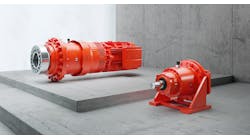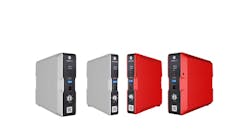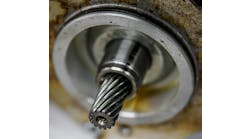There can be a lot of hype surrounding motor and drive efficiency. However, from a machine designer prospective, the new motor efficiency standards don't really affect the machine builder, but there are some things to be aware of. On the variable-frequency-drive (VFD) side of things, capabilities and features continue to improve, and you should know how reducing speed matters.
The U.S. Department of Energy (DOE) has been involved with energy efficiency standards since 1975 when it released the 10 CFR Part 431 Energy Conservation Program. As of June 1, the Department of Energy 10 CFR Part 431 Energy Conservation Program: Energy Conservation Standards for Commercial and Industrial Electric Motors; Final Rule, is in effect. This standard references the National Electrical Manufacturers Association (NEMA) standards and the 2007 Energy Independence & Security Act (EISA), both of which are important.
As an energy-saving initiative, these motor efficiency standards continue to be enhanced in order to increase energy efficiency. The new standard closed many of the loopholes in the rules. Many of the motor styles that were once exempt must now meet the amended rules.
This 82-page amended standard, Part 431, has much to say about constant-speed motors in the 1-to-500-hp range. The standard doesn't change the efficiency levels of motors covered under the previous standard, but it now applies to some motor styles that were previously exempt. These include Design A motors from 201-500 hp, Design C motors, U frame motors, IEC 100 frame motors with non-standard endplates or flanges, vertical hollow shaft motors and close-coupled pump motors. This means most motors rated for 600 V or less must comply with full-load efficiency levels defined in NEMA MG1-2011 (Table 12-12).
The standard does note that both single-phase and variable-speed motors aren’t covered in the amended standards, but standards are on the way to improve variable-speed-motor efficiency as part of a system. Systems will be getting more efficient, as well. There is also some overlap with the DOE small motors rule (Federal regulation 10 CFR 431.442), but this should be cleaned up in a few years.
So, what does this mean to the machine builder? It means that all new applications will use a premium efficiency motor because that is all that is sold at this point. Almost all motors manufactured must comply with the new motor efficiency standard. Motors that may have been previously exempt and don't meet the standards are no longer manufactured or imported for sale. This has a big effect on the motor manufacturers and distributors, but there is not much impact on the end users unless they were using cheap motors or taking advantage of loopholes.
If previously exempt motors are used on existing machined designs, a new motor will likely need to be specified. The designer should be aware that the new energy-efficient motors typically have more copper in them, possibly making them larger. It will need to be confirmed that the new motors will fit in the machine. A close look at the motor specifications may also find some higher inrush currents, depending on the motor design, and slightly higher speeds due to less slip in NEMA premium efficiency motors. The inrush currents and speed may impact the machine design.
One of the ways to save on electricity, besides using premium efficiency motors, is to run the motor more slowly, if possible. Pump and fan applications are good examples where lowering motor speed can greatly reduce electrical costs.
A variable frequency drive (VFD) is an easy way to make small changes in the motor speed and have an equal effect on the flow, a larger effect on the pressure and even larger effect on the horsepower required. Check out the pump affinity laws. Without changing the impeller diameter, the capacity (flow) of a pump is directly proportional to the speed it is run at. However, the pressure is directly proportional to the square of the speed, and the power (hp) is directly proportional to the cube of speed.
Using the pump affinity laws and a VFD, changing the pump or fan speed to 80% rated speed, the flow will be 80%, the pressure is 64% of rated but the horsepower required is only 51% of rated. If it works for the application, run the motor more slowly using a VFD. Run it really slowly if possible since running at 50% rated speed only requires 13% of the rate horsepower.
For all new motor purchases you should just stick with premium efficiency. The manufacturers and vendors will be happy to assist you with specifying the motor. While you are at it, check out some VFDs that will fit easily into the control system. Easy integration, gentle starts and stops and energy savings due to reduced speeds work best for the future applications.
Homepage image courtesy of Stuart Miles at FreeDigitalPhotos.net






